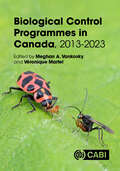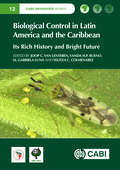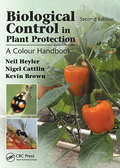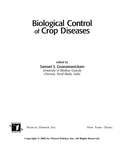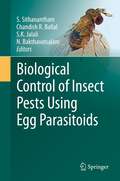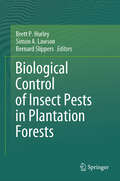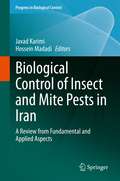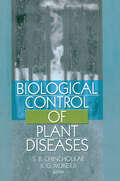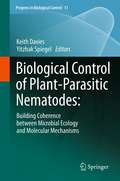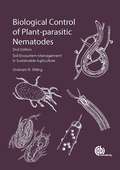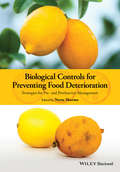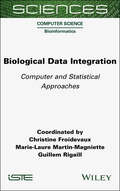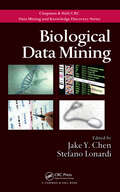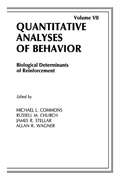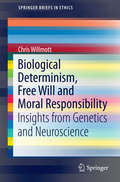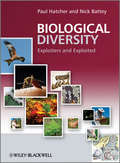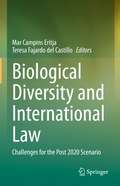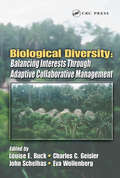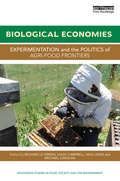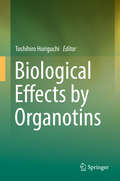- Table View
- List View
Biological Control Programmes in Canada, 2013-2023
by Charles Vincent Ian Scott Patrice Bouchard Tim Haye Rosemarie De Clerck-Floate Naomi Cappuccino Jacques Brodeur John Gavloski Martin Erlandson Frédéric Jean Kathleen Ryan Eric Lucas Jon Sweeney Alec McClay Marianne Elliott Christopher Saunders Tim J Dumonceaux Maya Evenden Christine Noronha Anne-Marie Fortier Gene Jones Dr Gary Gibson Marc Kenis Natalia Kirichenko John C. Vederas Paul K. Abram Susanna Acheampong Patrice Audy Jacob V. Basso Tracey Baute Roger L. Becker Koïchi Beltrando Andrew M.R. Bennett Jonathan Bernardo-Santos Suzanne E. Blatt Michael K. Bomford Sébastien Boquel Robert S. Bourchier Susan M. Boyetchko Andrea M. Brauner Luc Brodeur Rosemarije Buitenhuis Erin Bullas-Appleton Juli Carrillo Allan L. Carroll Haley Catton Daniel Cormier Ghislaine Cortat Jenny S. Cory Joan E. Cossentine Isabelle Couture Massimo Cristofaro Carly A. Demers Pauline S. Deschodt Peggy L. Dixon Josée Doyon Shelby V. Dufton François Dumont David J. Ensing Nadir Erbilgin Diana Catalina Fernandez José L. Fernández-Triana Jeffrey G. Fidgen Annabelle Firlej Kevin D. Floate François Fournier Marc Fournier Michelle T. Franklin Annie-Ève Gagnon Bruno Gallant Tara D. Gariepy John F. Gaskin Justin M. Gaudon Eric M. Gerbrandt Pierre Girod Angela E. Gradish Sara Grauby Vojislava Grbic Patrick Häfliger Rebecca H. Hallett Vincent A. Hervet Hariet L. Hinz Tracy K. Hueppelsheuser Corey Hughes Lauréline F. Humair Jeremy Hummel Sarah Jandricic Alida F. Janmaat Rob C. Johns Ian M. Jones Amanda M. Jorgensen Gary J. Judd J. Todd Kabaluk Elizabeth J. Katovich Christopher W. Kirby Jennifer G. Klutsch Didier Labarre Roselyne M. Labbé Geneviève Labrie Simon Lachance Jacques Lasnier Jean-Philippe Légaré Jason Lemay Serena K. Leo Jeffrey L. Littlefield Felix Longpré Marlee-Ann E. Lyle Jesse L. MacDonald Maggie MacDonald Chris J. MacQuarrie Francesca Marini Valerie Marshall Véronique Martel Cara McCreary Michael J. McTavish Jacob H. Miall Val Miller Chandra E. Moffat Debra L. Moreau Boyd A. Mori Benoit Morin Tyler D. Nelson Owen O. Olfert Jennifer K. Otani Emily Owens Jean-Philippe Parent Carolyn K. Parsons Erica E. Pate Cyrane Pouët Caroline Provost Justin M. Renkema Tamara Richardson Sabrina Rondeau Albert Remus Rosana Lucas E. Roscoe Krista Ryall Mark Schwarzländer Cynthia Scott-Dupree Simon Francis Shamoun Jade Sherwood Dylan M. Sjolie Timothy Skuse Jocelyn Smith Sandy M. Smith Juliana J. Soroka Michael Stastny Sonja Stutz Ashley Summerfield Ivo Toševski Amanda P. Tracey Susan C. Turner Willem G. Herk Kate Van Rooyen Udari M. Wanigasekara Philip S.R. Weyl Hester E. Williams Jonathon L. Williams Warren H. WongBiological control is an important component of integrated and ecological pest management programmes. Its importance continues to increase as plant protection is challenged with climate change, invasive species, pesticide resistance, de-registration of pesticide active ingredients, and increasing consumer demands for sustainably produced food and fibre. Biological control is highly compatible with organic cropping systems and evolving pest management frameworks, including biovigilance. Canada continues to be a world leader in biological control research, development of biological control policy, and implementation of biological control programmes. This is the sixth volume of a series of books reporting on the status of biological control research and on biological control programmes employed in Canada. This volume features 58 case study chapters that describe the research and progress in implementation of biological control for pests including insects, mites, weeds, and plant pathogens. Topics important to biological control, including policy, emerging technologies, biological control in urban landscapes and future targets for biological control are reviewed. Although the volume focusses on the Canadian biological control experience, the chapters will be of interest to a global audience of researchers and students of biological control, risk assessment, ecology, and pest management. This book Offers a detailed analysis of the state-of-the-art of biological control in Canada. Explains how biological control research is responding to challenges including climate change and invasive alien species. Gives insights in effective risk assessment and pest management. It is a valuable resource for students and researchers of pest management and biological control, and for practitioners and policy-makers needing analysis of the practical implications of using this approach.
Biological Control in Latin America and the Caribbean: Its Rich History and Bright Future (CABI Invasives Series)
by Hugo César Arredondo-Bernal Jorge L. Sifontes Anobel Barba Lorena Barra-Bucarei César Basso Wagner Bettiol Fermin Blanco Helga Blanco-Metzler Claudia Carolina Antúnez Guillermo Cabrera Walsh Carmen C. Castillo Charlotte E. Causton Ronald D. CaveThe book summarizes the history of biological control in Latin America and the Caribbean. Few publications provide historical detail and the records are, therefore, fragmented until now. By bringing information together in this book, we offer a more complete picture of important developments in biological control on this continent. There are a wealth of text, tables and references about the history of such projects, and which were successful and which failed. This will help plan future biocontrol projects. An overview is provided of the current situation in biological control for many Latin American and Caribbean countries, revealing an astonishing level of practical biological control applied in the region, making it the largest area under biological control worldwide. The final part describes new developments and speculates about the future of biological control in Latin America and the Caribbean.
Biological Control in Plant Protection: A Colour Handbook, Second Edition
by Neil Helyer Nigel D. Cattlin Kevin C. BrownThere has been a large increase in the commercial use of integrated crop/pest management methods for pest and disease control on a wide range of crops throughout the world since the first edition of this book. The completely revised second edition of the bestselling Biological Control in Plant Protection: A Color Handbook continues the objective of
Biological Control of Crop Diseases
by Samuel S. GnanamanickamWith contributions from more than 30 internationally renowned experts, this book combines coverage of theory with coverage of global practices. Highlighting the day-to-day challenges of organic crop management for cost-effective real-world application, the book explores the biological control of diseases in 12 major crops. It focuses on the use of host plant resistance through transgenics and induced systemic resistance as a part of biological control. Topics covered include the role of biocontrol agents for signalling resistance, effective ecofriendly alternative to combat bacterial, fungal, and viral infestation, and transgenic crops in disease management.
Biological Control of Insect Pests Using Egg Parasitoids
by N Bakthavatsalam S. K. Jalali S. Sithanantham Chandish R. BallalThe theme of the book is highly relevant to the current emphasis on environment conservation, with focus on native biodiversity conservation in agro-ecosystems. The current impetus being given to organic farming and export oriented agri-hortculture in the country calls for access to relevant scientific knowledge base among the stakeholders. Research on biological pest control is more than a century old in India. Egg parasitoids, which are mainly tiny wasps, led by the family Trichogrammatidae, are the most widely utilized natural enemies for biological control globally. Over thirty countries are using these bioagents to protect over 10 million hectares of agricultural and forestry crops from many important insect pests. The book comprises 18 chapters, which are arranged in continuum, commencing with basic aspects of knowledge and ending in their utilization targets. The chapters cover broadly four areas: bio-diversity and natural occurrence of egg parasitoids, behaviour and adaptation of egg parasitoids, mass production and safe use of egg parasitoids and utilisation of egg parasitoids in different crop ecosystems. Some of the chapters cater to the needs of discipline-wise update on the current R&D scenario-like insect taxonomy, biotechnology, mass-production and quality control of the target organisms - egg-parasitoids, which are useful for laboratory scientists/researchers. There are also chapters devoted to knowledge status and scope for utilization of egg parasitoids in different target crops, which cater to requirements of field entomologists and extensionists for use in their tasks of guiding farmers/local guides. The book is different in approach, method, structure and content and ensures holistic coverage of the topic. The chapters are written by active and experienced workers in different crops and aspects and co-edited by four very experienced experts who have over three decades R&D experience in the subject. All the authors have uniformly focussed on comprehensive literature study and critical identification of knowledge gaps for future R&D, thus the book is novel in outlook, up-to-date in content and comprehensive in coverage of themes. This book will be useful for supplementary reading for MSc Agriculture and PhD Agriculture students, besides MSc/PhD research students in Zoology/Environmental Biology, who are specialising in Entomology. It would also serve as a very useful reference book for researchers worldwide, though focus is also there on Indian work. It addresses the special information needs of students and faculty, besides practitioners and extensionists in the Australasia and Africa regions and thus not limited to the R&D knowledge generated in developed countries.
Biological Control of Insect Pests in Plantation Forests
by Bernard Slippers Brett P. Hurley Simon A. LawsonThis book includes chapters focusing on the principles of biological control and influence of policy, ecology and diversity in establishing successful programs. Plantation forests have a crucial role to meet the fiber demands of a growing world population, especially considering the concerning decrease in the world’s total forest area. One of the greatest threats to the sustainability of plantation forestry is insect pests. Among the approaches that can be used to manage populations of insect pests, biological control is considered one of the most feasible and effective approaches to use in plantation forests. The authors review past and current major biological control programs in different plantation forest systems, including pine, eucalyptus and poplar, and including classical, conservation and augmentative approaches. Other chapters examine opportunities to use new technologies and integrated approaches and identify future challenges in the use of biological control.
Biological Control of Insect and Mite Pests in Iran: A Review from Fundamental and Applied Aspects (Progress in Biological Control #18)
by Javad Karimi Hossein MadadiThe book provides a reference to biological control of arthropod pests in agriculture and of public health importance in Iran. A quick glance over the literature shows a long history of biocontrol attempts in the country. Some historically important events highlighting the interest of Iranian academic, research and extension fields to the natural enemies and their applied aspects are provided. Iran, with an exception of the former USSR, was a pioneer in both basic and applied biocontrol in West Asia. The book consists of four parts: three parts for predators, parasitoids and pathogens, and last part for other approaches and analyses of the current state of biological control in Iran. The book provides the most up-to-date information on pest control and related topics of entomology in Iran. The chapters are written by scholars from major Universities and research centers in Iran.
Biological Control of Plant Diseases
by K. G. Mukerji S. B. ChincholkarPrevent agricultural loss with natural disease controls that don’t harm the environmentor the people who live in it Despite the worldwide use of chemicals and pesticides to control the devastating effects of plant disease, the international agribusiness market still suffers extensive economic losses each year. Biological Control of Plant Diseases offers natural alternatives to the synthetic fungicides, pesticides, herbicides, and insecticides that have not only failed to stop pests and pathogens, but have raised serious safety and environmental concerns. The world’s leading plant pathologists examine the use of antagonistic microorganisms, inherent resistance, and natural fungicides for plant protection that’s safe, economical, and effective. Biological Control of Plant Diseases presents up-to-date research findings on disease management to provide you with a single-source reference text for developing a sustainable ecosystem that doesn’t depend on harmful and unhealthy agrochemicals. This unique book acts as a catalyst for change, presenting fresh ideas and innovative strategies for finding meaningful solutions to the problems of disease control. Contributors working in the areas of plant protection, microbiology, plant pathology, biotechnology, ecology, and food safety examine topics that include the application of plant tissue culture, competitive root colonization, mycorrhiza in biocontrol, microbial siderophores, antagonism, and genetic regulation. Topics addressed in Biological Control of Plant Diseases include: soil-borne pathogens rhizobacteria organic acids white rot Trichoderma and Agrobacterium phyllosphere manure-based microbes gray mold disease major fungal diseases mycoparasitism microbial chitinases and much
Biological Control of Plant-Parasitic Nematodes: Building Coherence between Microbial Ecology and Molecular Mechanisms (Progress in Biological Control #11)
by Yitzhak Spiegel Keith DaviesThe offered volume intends to review the biological control theme of phytonematodes from several prospects: ecological; applicative as well as commercial state of the art; understanding the mode-of-action of various biocontrol systems; interaction between the plant host, nematodes' surface and microorganism's; candidates for biocontrol; extrapolation of the wide knowledge existed in another systems for understanding biocontrol processes: C. elegans as a model and lessons from other natural systems; and exploiting advanced genomic tools to promote understanding biocontrol processes and thereafter improve specific biological control agents.
Biological Control of Plant-parasitic Nematodes
by Graham StirlingPlant-parasitic nematodes are one of multiple causes of soil-related sub-optimal crop performance. This book integrates soil health and sustainable agriculture with nematode ecology and suppressive services provided by the soil food web to provide holistic solutions. Biological control is an important component of all nematode management programmes, and with a particular focus on integrated soil biology management, this book describes tools available to farmers to enhance the activity of natural enemies, and utilize soil biological processes to reduce losses from nematodes.
Biological Control of Plant-parasitic Nematodes: Soil Ecosystem Management in Sustainable Agriculture
by Graham StirlingPlant-parasitic nematodes are one of multiple causes of soil-related sub-optimal crop performance. This book integrates soil health and sustainable agriculture with nematode ecology and suppressive services provided by the soil food web to provide holistic solutions. Biological control is an important component of all nematode management programmes, and with a particular focus on integrated soil biology management, this book describes tools available to farmers to enhance the activity of natural enemies, and utilize soil biological processes to reduce losses from nematodes.
Biological Control: Case Studies from Around the World
by Charles Vincent Mark S. Goettel George LazarovitsBiological control, the management of pests by the use of living organisms, has a long history of application to agriculture around the world. However, the effective use of beneficial organisms is constrained by environmental, legal, and economic restrictions, forcing researchers to adopt increasingly multi-disciplinary techniques in order to deploy successful biological control programs. It is this complex process, including the mindset and the social environment of the researcher as well as the science being pursued, that this book seeks to capture. Chapters reveal the experiences of scientists from the initial search for suitable control agents, to their release into ecosystems and finally to the beneficial outcomes which demonstrate the great success of biological control across diverse agro-ecosystems. Drawing together historical perspectives and approaches used in the development of biological control as well as outlining current debates surrounding terminology and differential techniques, Biological Control: A Global Perspective will be a valuable resource.
Biological Controls for Preventing Food Deterioration: Strategies for Pre- and Postharvest Management
by Neeta SharmaVarious biotic factors cause diseases in crops, which result in food losses. Historically pesticide development has been instructive to us in terms of the benefits derived as well as the hazards that accompany their indiscriminate use. The application of fertilizers and pesticides to crops has become a norm in agricultural production, but this has led to resurgence in pests as they have developed resistance to such chemicals. Biological control of plant pests and pathogens is part of the solution to this problem. This is an area that continues to inspire research and development. It is also the foundation on which sustainable, non-polluting pest control for tomorrow’s farms must be built. Biological Controls for Preventing FoodDeterioration provides readers with options of non-chemical, eco-friendly, environmentally safe natural alternatives to prevent food from spoilage at pre- and postharvest stages. It covers the principles behind these techniques and their implementation. By integrating theory and practice, this book discusses the potential and associated problems in the development of non-chemical alternatives to protect food and addresses the common hurdles that need to be overcome to enable commercialization and registration of natural products for combating diseases. Focussing on plant foods, this timely book is unique in scope as it offers an international perspective on food deterioration caused by bacterial, fungal, viral, and mycotoxin contamination. It brings together highly respected scientists from differingyet complementary disciplines in one unified work that is important reading for food safety professionals, researchers and students.
Biological Data Integration: Computer and Statistical Approaches
by Christine Froidevaux Marie-Laure Martin-Magniette Guillem RigaillThe study of biological data is constantly undergoing profound changes. Firstly, the volume of data available has increased considerably due to new high throughput techniques used for experiments. Secondly, the remarkable progress in both computational and statistical analysis methods and infrastructures has made it possible to process these voluminous data. The resulting challenge concerns our ability to integrate these data, i.e. to use their complementary nature effectively in the hope of advancing our knowledge. Therefore, a major challenge in studying biology today is integrating data for the most exhaustive analysis possible. Biological Data Integration deals in a pedagogical way with research work in biological data science, examining both computational approaches to data integration and statistical approaches to the integration of omics data
Biological Data Mining (Chapman & Hall/CRC Data Mining and Knowledge Discovery Series)
by Stefano Lonardi Jake Y. ChenLike a data-guzzling turbo engine, advanced data mining has been powering post-genome biological studies for two decades. Reflecting this growth, Biological Data Mining presents comprehensive data mining concepts, theories, and applications in current biological and medical research. Each chapter is written by a distinguished team of interdisciplin
Biological Determinants of Reinforcement: Biological Determinates of Reinforcement (Quantitative Analyses of Behavior Series)
by Michael L. Commons Russell M. Church James R. Stellar Allan R. WagnerThis seventh volume, divided into four parts, addresses the biological determinates of reinforcement and memory. Covers topics in electrical brain stimulation, drugs and reinforcement, and cellular mechanisms.
Biological Determinism, Free Will and Moral Responsibility: Insights from Genetics and Neuroscience (SpringerBriefs in Ethics)
by Chris WillmottThis book examines the way in which new discoveries about genetic and neuroscience are influencing our understanding of human behaviour. As scientists unravel more about the ways in which genes and the environment work together to shape the development of our brains, their studies have importance beyond the narrow confines of the laboratory. This emerging knowledge has implications for our notions of morality and criminal responsibility. The extent to which "biological determinism" can be used as an explanation for our behaviour is of interest to philosophers reflecting on the free will versus determinism debate. It also has repercussions for the criminal justice system; in courtrooms around the world, defence lawyers are beginning to appeal to genetic and brain imaging data as grounds for finding their clients not guilty. Can a defendant's genes or the structure of his brain be used as an excuse for his behaviour? Is criminality "hardwired"? Is it legitimate to claim "I couldn't help it, my genes made me do it"? This book appeals to anyone interested in the link between behaviour and genetics, the science and philosophy of moral responsibility and/or criminal law.
Biological Diversity
by Nick Battey Paul HatcherBiological Diversity takes a fresh, innovative approach to the teaching of biodiversity. Rather than detailing and cataloguing the major taxa and their evolutionary relationships, the authors have selected 18 groups of organisms and used these as a framework in which to discuss the species and their interactions with man and each other. There is a strong narrative theme throughout - the exploited and the exploiters - and, in many cases, there is emphasis on the historical context. A wide range of organisms are covered, from the unicellular to birds and mammals and with an equal consideration of plants and animals. Species have been chosen for their ability to best illustrate particular biological principles, and for their strong interaction with other species.After an introduction the book is divided into two parts: 'Exploited' and 'Exploiters'. Each of the chapters, although linked to each other, forms a stand-alone essay. They are scientifically rigorous, up-to-date and do not shy away from addressing some controversial issues. Chapters have' text boxes' highlighting important issues and concepts, lists of further reading and references. In addition to tables and figures the book has a selection of original illustrations drawn by leading artist Steven Appleby.This fresh approach will appeal to all those interested in the biological sciences, and aims to be accessible to people with a diversity of backgrounds. It will prove particularly useful to biology students, enabling them to get to grips with important biological principles and concepts that underpin the diversity of life, and the interrelationship of humans with other groups of organisms.
Biological Diversity and International Law: Challenges for the Post 2020 Scenario
by Mar Campins Eritja Teresa Fajardo del CastilloThe book focuses on the interactions between international legal regimes related to biodiversity governance. It addresses the systemic challenges by analyzing the legal interactions between international biodiversity law and related international law applicable to economic activities, as well as issues related to the governance of biodiversity based on functional, normative, and geographic dimensions, in order to present a crosscutting, holistic approach. The global COVID-19 pandemic, the imminent revision of the Strategic Plan for Biodiversity 2011-2020, and the Aichi Targets have created the momentum to focus on the interactions between the Convention on Biological Diversity and other international environmental regimes. Firstly, it discusses the principles that inspire biodiversity-related conventional law, the soft law that conveys targets for enforcement of the Biodiversity Convention, their structural, regulatory and implementation gaps, the systemic relations arising from national interests, and the role of scientific advisory bodies in biodiversity-related agreements. The second part then addresses interactions in specific conventional frameworks, such as the law of multilateral trade and global public health, and the participation of communities in the management of genetic resources. Lastly, the third part illustrates these issues using four case studies focusing on the challenges for sustainability and marine biodiversity in small islands, the Arctic Ocean, the Caribbean Sea, and the Mediterranean Sea, as a way to strengthen a horizontal and joint approach. The book is primarily intended for academics, researchers, and students interested in international environmental law and policy and in interactions for creating conditions for fair, sustainable, and resilient environmental development. By offering an analysis of instruments and criteria for systemic relations in those areas, it will also appeal to public and private actors at the domestic and international level.
Biological Diversity: Balancing Interests Through Adaptive Collaborative Management
by John Schelhas Eva Wollenberg Louise E. Buck Charles C. GeislerWe live in a world of wide pendulum swings regarding management policies for protected areas, particularly as they affect the involvement of local people in management. Such swings can be polarizing and halt on-the-ground progress. There is a need to find ways to protect biodiversity while creating common ground and building management capacity thr
Biological Drug Products: Development and Strategies
by Manmohan Singh Wei WangTested and proven solutions to the challenges of biological drug product development Biological drug products play a central role in combating human diseases; however, developing new successful biological drugs presents many challenges, including labor intensive production processes, tighter regulatory controls, and increased market competition. This book reviews the current state of the science, offering readers a single resource that sets forth the fundamentals as well as tested and proven development strategies for biological drugs. Moreover, the book prepares readers for the challenges that typically arise during drug development, offering straightforward solutions to improve their ability to pass through all the regulatory hurdles and deliver new drug products to the market. Biological Drug Products begins with general considerations for the development of any biological drug product and then explores the strategies and challenges involved in the development of specific types of biologics. Divided into five parts, the book examines: Part 1: General Aspects Part 2: Proteins and Peptides Part 3: Vaccines Part 4: Novel Biologics Part 5: Product Administration/Delivery Each chapter has been prepared by one or more leading experts in biological drug development. Contributions are based on a comprehensive review and analysis of the current literature as well as the authors' first-hand experience developing and testing new drugs. References at the end of each chapter serve as a gateway to original research papers and reviews in the field. By incorporating lessons learned and future directions for research, Biological Drug Products enables pharmaceutical scientists and students to improve their success rate in developing new biologics to treat a broad range of human diseases.
Biological Economies: Experimentation and the politics of agri-food frontiers (Routledge Studies in Food, Society and the Environment)
by Michael Carolan Hugh Campbell Nick Lewis Richard Le HeronRecent agri-food studies, including commodity systems, the political economy of agriculture, regional development, and wider examinations of the rural dimension in economic geography and rural sociology have been confronted by three challenges. These can be summarized as: ‘more than human’ approaches to economic life; a ‘post-structural political economy’ of food and agriculture; and calls for more ‘enactive’, performative research approaches. This volume describes the genealogy of such approaches, drawing on the reflective insights of more than five years of international engagement and research. It demonstrates the kinds of new work being generated under these approaches and provides a means for exploring how they should be all understood as part of the same broader need to review theory and methods in the study of food, agriculture, rural development and economic geography. This radical collective approach is elaborated as the Biological Economies approach. The authors break out from traditional categories of analysis, reconceptualising materialities, and reframing economic assemblages as biological economies, based on the notion of all research being enactive or performative.
Biological Effectors of Social Determinants of Health in Cancer: Identification and Mitigation: Proceedings of a Workshop
by Board on Health Care Services National Cancer Policy Forum National Academies of Sciences, Engineering, and Medicine Health and Medicine DivisionSocial determinants of health, including factors such as the conditions in which people are born, grow, work, live, and age; their education and income; and many other elements can influence their likelihood of developing cancer, the type of cancer, the cancer stage at diagnosis, the quality of care they receive, and their health outcomes. The National Cancer Policy Forum hosted a workshop in March 2024 to examine the complex interactions among biological variables and these factors and their impact on cancer-related health outcomes and health equity.
Biological Effects by Organotins
by Toshihiro HoriguchiThis book provides an overview of the induction mechanism of imposex caused by organotin compounds in gastropods, as well as fundamental information on the physiology and biochemistry of reproduction in mollusks. Are the sex hormones of gastropod mollusks vertebrate-type steroids, or neuropeptides? What about lipid disturbance and membrane toxicity due to organotin compounds? The book also discusses the latest findings on the role of nuclear receptors, such as retinoid X receptor (RXR), retinoic acid receptor (RAR) and peroxisome proliferator-activated receptor (PPAR), in the development of imposex in gastropods. Further, it describes the current state of contamination by organotins in the marine environment and gastropod imposex, especially focusing on Europe and Asia, introduces readers to analytical techniques for organotin compounds, and assesses the contamination and adverse effects of alternatives to organotin-based antifouling paints. Imposex, a superimposition of male genital tracts, such as penis and vas deferens, on female gastropod mollusks, is known as a typical phenomenon or consequence of endocrine disruption in wildlife. Imposex is typically induced by very low concentrations of organotin compounds, such as tributyltin (TBT) and triphenyltin (TPhT) from antifouling paints on ships and fishing nets. Reproductive failure may be brought about in severely affected stages of imposex, resulting in population decline and/or mass extinction. Thus, gastropod imposex has been recognized as a critical environmental pollution issue. Although gastropod imposex is also highly interesting for the biological sciences because of its acquired pseudohermaphroditism and/or sex change by certain chemicals, such as TBT and TPhT, the mechanism that induces the development of imposex remains unclear, possibly due to our limited understanding of the endocrinology of gastropod mollusks. This book offers a useful guide for professionals and students interested in the fields of aquatic biology, invertebrate physiology, ecotoxicology and environmental science.
Biological Effects of Fibrous and Particulate Substances (Current Topics in Environmental Health and Preventive Medicine #0)
by Takemi Otsuki Yasuo Yoshioka Andrij HolianThis volume examines our current understanding of the biological effects of fibrous and particulate substances, including discussions on nanoparticles. It offers comprehensive information on the latest insights into the immunological effects of various irritants on the human body. Readers will benefit from the contributing authors' diverse perspectives and extensive discussions of key issues, which include molecular alterations of the immune system and autoimmune diseases in connection with asbestos and silica, among others. The chapters also discuss recommendations, practical methods, and nanosafety science in situations involving exposure to nanotoxic substances. Edited in collaboration with the Japanese Society for Hygiene, this book provides up-to-date information on the immunological effects of nanotoxic substances to researchers interested in environmental and occupational health. Presenting a number of recent concepts and findings in the field, it enables readers to gain a comprehensive knowledge of health problems caused by environmental fibrous and particulate substances.
